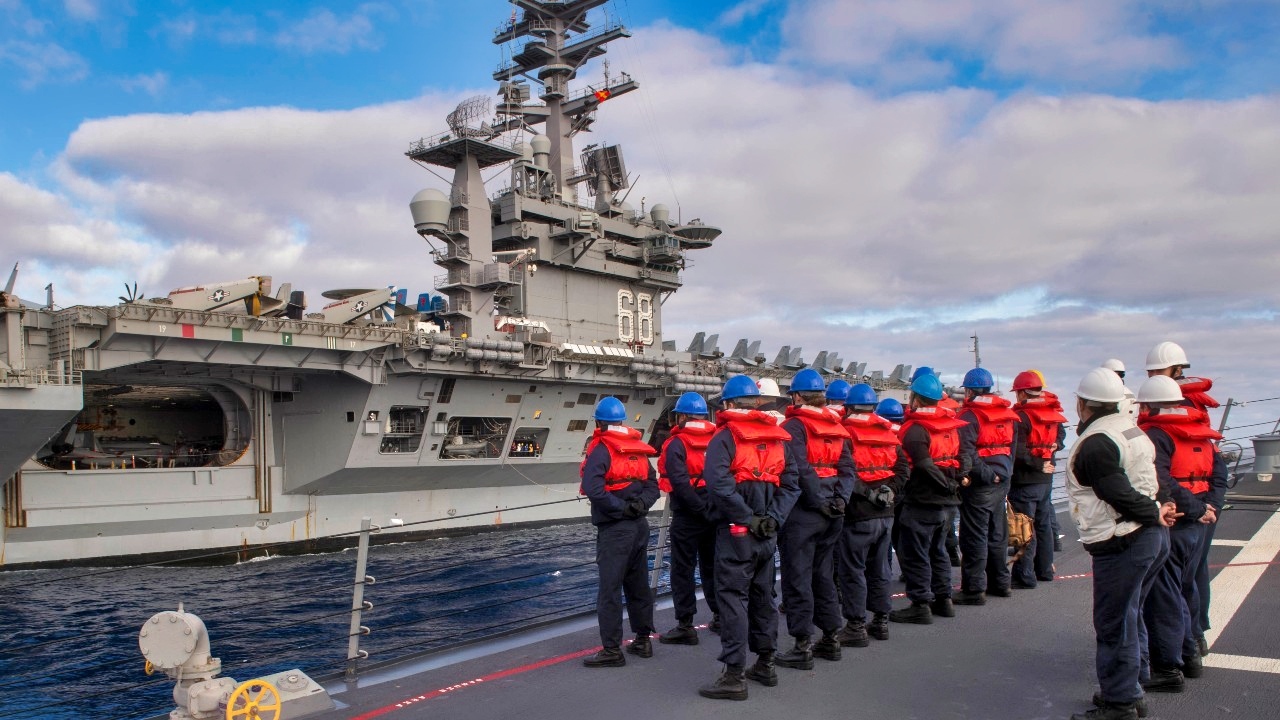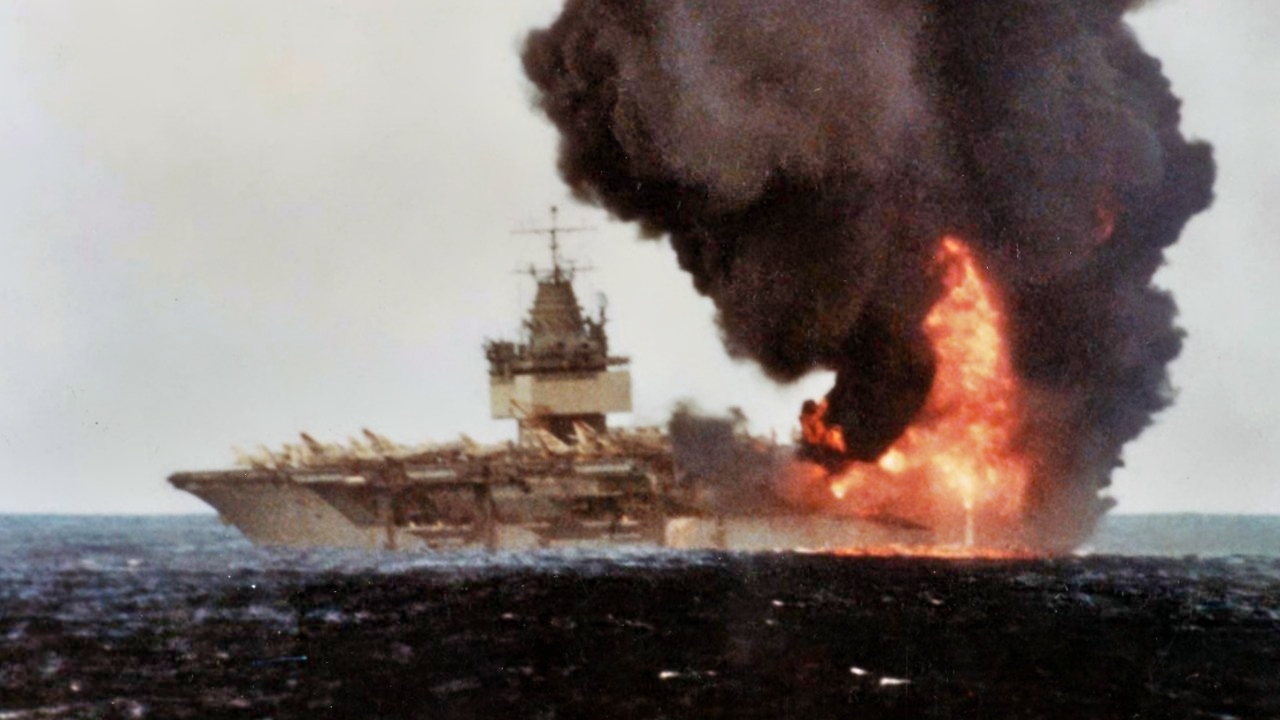Key Points and Summary – Millennium Challenge 2002 was a $250 million wargame that ended in a stunning, controversial defeat for U.S. forces.
-Commanding the adversary “Red Team,” retired Marine Lt. Gen. Paul Van Riper rejected high-tech warfare, instead using low-tech methods like motorcycle couriers and a swarm of small boats.

ATLANTIC OCEAN (Oct. 29, 2019) USS Gerald R. Ford (CVN 78) conducts high-speed turns in the Atlantic Ocean. Ford is at sea conducting sea trials following the in port portion of its 15 month post-shakedown availability. (U.S. Navy photo by Mass Communication Specialist 3rd Class Connor Loessin)

Sailors prepare to man the rails as Nimitz-class aircraft carrier USS Carl Vinson (CVN 70) arrives at Joint Base Pearl Harbor-Hickam for Exercise Rim of the Pacific (RIMPAC) 2024, June 25. Twenty-nine nations, 40 surface ships, three submarines, 14 national land forces, more than 150 aircraft and 25,000 personnel are participating in RIMPAC in and around the Hawaiian Islands, June 27 to Aug. 1. The world’s largest international maritime exercise, RIMPAC provides a unique training opportunity while fostering and sustaining cooperative relationships among participants critical to ensuring the safety of sea lanes and security on the world’s oceans. RIMPAC 2024 is the 29th exercise in the series that began in 1971. (U.S. Navy photo by Mass Communication Specialist 2nd Class Leon Vonguyen)
-His surprise, asymmetric attack resulted in the simulated sinking of an entire U.S. aircraft carrier strike group, representing a loss of 16 ships and 20,000 personnel.
-After this decisive defeat, the exercise was reset with artificial constraints, prompting Van Riper to quit and criticize the event as scripted.
The Time a U.S. General Sank His Own Navy’s Aircraft Carrier
Millennium Challenge 2002 was one of the most expensive war games ever run by the United States. At $250 million, the event involved a blend of live exercises and computer simulations to evaluate network-centric warfare and validate the United States’ ability to use its advantages in information collection and collation, communications, and precision strike capabilities to secure a decisive victory in the early stages of a conflict.
Two sides faced off: The Blue Team, represented American forces, and the Red Team, a hypothetical and unnamed Middle Eastern adversary, was commanded by retired Marine Corps Lieutenant General Paul Van Riper.
The leeway afforded to the general to command his forces as he saw fit was designed to give the game a veneer of reality—one that Van Riper used to great advantage.
Rather than waiting for Blue Team to strike, Van Riper instead used asymmetric tactics, relying on unusual low-tech techniques to avoid communication interception and disruption and pre-empt Blue Team’s plans. Using light signals rather than radio or satellite communications, and a fleet of motorcycle couriers to deliver commands, Van Riper launched a coordinated surprise attack on Blue Team. General Van Riper’s attack resulted in a decisive Red Team victory.
Employing a swarm of small boats—not dissimilar to those used by Iran’s Islamic Revolutionary Guard Corps—Van Riper’s forces launched a devastating and unexpected simulated salvo against a naval task force in the Persian Gulf.
The aftermath was devastating: sixteen ships sunk or disabled, including an aircraft carrier, several cruisers, and amphibious assault ships. Had the attack been more than a simulation, it would have resulted in the loss of up to 20,000 service members.
Following the Red Team victory, the architects of Millennium Challenge 2002 reset the game and restricted Red Team.
The result appeared to be a scripted exercise aimed at rubber-stamping validation of the Blue Team’s strategic doctrine of technological reliance.
Millennium Challenge 2002: A Review
In a fascinating and insightful interview given to PBS in 2004, Van Riper gave his account of what happened during Millennium Challenge 2002. The interview was part of a broader analysis by the public broadcaster on the impact of U.S. technology on the wars in Afghanistan and Iraq.
One of the lieutenant general’s core beliefs about the exercise is that an over-reliance on technology ignores the sheer chaos that characterizes warfare—and could be detrimental to victory.
“My experience has been that those who focus on the technology, the science, tend towards sloganeering. There’s very little intellectual content to what they say, and they use slogans in place of this intellectual content,” he said.

The French Marine Nationale aircraft carrier FS Charles De Gaulle (R91), and the aircraft carrier USS John C. Stennis (CVN 74) are underway in formation in the Red Sea, April 15, 2019. The John C. Stennis Carrier Strike Group is deployed to the U.S. 5th Fleet area of operations in support of naval operations to ensure maritime stability and security in the Central Region, connecting the Mediterranean and the Pacific through the western Indian Ocean and three strategic choke points. (U.S. Navy photo by Mass Communication Specialist Seaman Joshua L. Leonard)
“It does a great disservice to the American military, the American defense establishment. ‘Information dominance,’ ‘network-centric warfare,’ ‘focused logistics’—you could fill a book with all of these slogans.”
Though spoken more than 20 years ago, Van Riper’s comments are still highly relevant today, when technology tempts with promises of quick, bloodless future victories.
“What I see are slogans masquerading as ideas,” Van Riper at the time. “In a sense, they make war more antiseptic. They make it more like a machine. They don’t understand it’s a terrible, uncertain, chaotic, bloody business. So they can lead us the wrong way. They can cause people not to understand this terrible, terrible phenomenon.”
Though Lieutenant General Van Riper acknowledged the crucial role that technology plays on the battlefield—one has only to look to the ongoing war in Ukraine to see how technological innovations such as First Person View drones have transformed the battlefield—he emphasized that technology is no substitute for leadership and ideas.
“The first thing you have to understand is how you plan to fight in the future or in a particular engagement, a particular war,” Van Riper said. “And once you understand how you’re going to fight, then you bring the technology to it. If you lead with the technology, I think you’re bound to make mistakes.”
In the years since Millennium Challenge was run, accusations of unfair play have been leveled at the game’s organizers, a charge that Van Riper vehemently denied.

(June 11, 2017) Sailors aboard the Arleigh Burke-class guided-missile destroyer USS Pinckney (DDG 91) stand in formation as the ship pulls alongside the aircraft carrier USS Nimitz (CVN 68) to conduct a replenishment-at-sea. The Pinckney is currently underway as part of the Nimitz Carrier Strike Group on a regularly scheduled deployment to the Western Pacific and Indian Oceans. (U.S. Navy photo by Mass Communication Specialist 2nd Class Craig Z. Rodarte/Released)
“There were accusations that Millennium Challenge was rigged,” he said. “I can tell you it was not. It started out as a free-play exercise, in which both Red and Blue had the opportunity to win the game. However, about the third or fourth day, when the concepts that the command was testing failed to live up to their expectations, the command then began to script the exercise in order to prove these concepts.
“This was my critical complaint. You might say, ‘Well, why didn’t these concepts live up to the expectations?’ I think they were fundamentally flawed in that they leaned heavily on technology. They leaned heavily on systems analysis of decision-making.”
About the Author: Caleb Larson
Caleb Larson is an American multiformat journalist based in Berlin, Germany. His work covers the intersection of conflict and society, focusing on American foreign policy and European security. He has reported from Germany, Russia, and the United States. Most recently, he covered the war in Ukraine, reporting extensively on the war’s shifting battle lines from Donbas and writing on the war’s civilian and humanitarian toll. Previously, he worked as a Defense Reporter for POLITICO Europe. You can follow his latest work on X.
More Military
Russia’s T-14 Armata Super Tank Mistake Still Stings
SR-72 Darkstar: The Mach 6 Mothership for the F-35 and F-47
China’s J-20 Mighty Dragon Fighter Can Be Summed Up In Just 4 Simple Words
The MBT-70 Tank Still Haunts the U.S. Army
Russia’s ‘New’ MiG-35 Fighter Is Officially ‘Circling the Drain’










